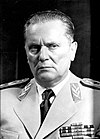| This article needs additional citations for verification. Please help improve this article by adding citations to reliable sources. Unsourced material may be challenged and removed. Find sources: "1968 student demonstrations in Yugoslavia" – news · newspapers · books · scholar · JSTOR (August 2021) (Learn how and when to remove this message) |
You can help expand this article with text translated from the corresponding article in Serbian. (August 2021) Click for important translation instructions.
|

Student protests were held in Belgrade, Yugoslavia, as the first mass protest in Yugoslavia after World War II. Protests then also erupted in some of the capitals of the other Yugoslav republics — Sarajevo, Zagreb and Ljubljana — but they were smaller and shorter-lasting than those in Belgrade.
On the night of 2 June 1968, students of the Belgrade University initiated a seven-day strike. The police responded by beating the student protestors and banning all public gatherings. Ignoring the ban, the student protestors then gathered at the Faculty of Philosophy, held debates and speeches on social justice, and distributed copies of the banned magazine Student. Students also protested against economic reforms, which led to high unemployment and workers leaving the country and finding work elsewhere. In Ljubljana, more than 5000 people gathered on Prešern square. They were violently dispersed by police units from Croatia using batons, tear gas and water canons. Hundreds were injured. Leading public figures, including film director Dušan Makavejev, stage actor Stevo Žigon, poet Desanka Maksimović, and numerous university professors, lent their support to the protests and in so doing found themselves running into problems in their careers because of their connections to the protests.
President Josip Broz Tito gave a televised speech on June 9, which ultimately led to the cessation of the protests, as he conceded that the "students are right" and gave in to some of their demands. However, in the years that followed, he retaliated against the leaders of the protests by imprisoning students (Vladimir Mijanović, Milan Nikolić, Pavluško Imširović, Lazar Stojanović and others) and by firing critical professors from university positions and Communist party posts.
See also
References
- "Belgrade's 1968 student unrest spurs nostalgia". Thaindian. 5 June 2008. Archived from the original on 30 December 2016. Retrieved 26 August 2010.
- "1968 in Europe - Online teaching and research guide". Archived from the original on 9 June 2008.
Sources
- "Down with the Red Bourgeoisie of Yugoslavia: An Analysis of the June Students' Insurrection in Belgrade, Yugoslavia" (November 1968). Black & Red. No. 3.
- Fredy Perlman (1969). "Birth of a Revolutionary Movement in Yugoslavia".
- D. Plamenic (March–April 1969). "Belgrade Student Insurrection". New Left Review. No. 54.
- Madigan Fichter (2016). "Yugoslav Protest: Student Rebellion in Belgrade, Zagreb, and Sarajevo in 1968". Slavic Review. 75 (1): 99–121. doi:10.5612/slavicreview.75.1.99.
| Josip Broz Tito | ||
|---|---|---|
| ||
| Life and politics |
|  |
| Premiership | ||
| Presidency | ||
| Family |
| |
| Legacy | ||
This Yugoslavia-related article is a stub. You can help Misplaced Pages by expanding it. |
This article related to History of Serbia is a stub. You can help Misplaced Pages by expanding it. |
